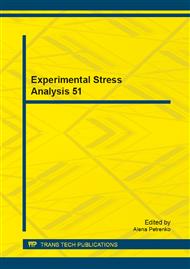[1]
J. Li, J. Suo, P. Zou, L. Jia & S. Wang, Structure, Corrosion Behavior and Mechanical Property of a Novel Poly(vinyl alcohol) Composite in Simulated Body Fluid, Journal of Biomaterials Science-Polymer Edition. 21 (2010) 863-876.
DOI: 10.1163/156856209x448084
Google Scholar
[2]
H. Kim, T. Ito, B. Kim, Y. Watanabe & I. Kim, Mechanical Properties, Morphologies, and Microstructures of Novel Electrospun Metallized Nanofibers, Adv. Eng. Mater. 13 (2011) 376-382.
DOI: 10.1002/adem.201000320
Google Scholar
[3]
Y. Kim, Y. Choi, K. Kim & S. Choi, Evaluation of copper ion of antibacterial effect on Pseudomonas aeruginosa, Salmonella typhimurium and Helicobacter pylori and optical, mechanical properties, Appl. Surf. Sci. 258 (2012) 3823-3828.
DOI: 10.1016/j.apsusc.2011.12.036
Google Scholar
[4]
Y. Wu, F. Li, Y. Wu, W. Jia, P. Hannam, J. Qiao, & G. Li, Formation of silica nanofibers with hierarchical structure via electrospinning, Colloid Polym. Sci. 289 (2011) 1253-1260.
DOI: 10.1007/s00396-011-2455-3
Google Scholar
[5]
G. Faggio, V. Modafferi, G. Panzera, D. Alfieri, S. Santangelo. Micro-Raman and photoluminescence analysis of composite vanadium oxide/poly-vinyl acetate fibres synthesised by electro-spinning, J. Raman Spectrosc. 43 (2012) 761-768.
DOI: 10.1002/jrs.3089
Google Scholar
[6]
M. Parizek, T.E.L. Douglas, K. Novotna, A. Kromka, M.A. Brady, A. Renzing, E. Voss, M. Jarosova, L. Palatinus, P. Tesarek, P. Ryparova, V. Lisa, A.M. dos Santos, P.H. Warnke & L. Bacakova, Nanofibrous poly (lactide-co-glycolide) membranes loaded with diamond nanoparticles as promising substrates for bone tissue engineering, Int. J. Nanomedicine 7 (2012).
DOI: 10.2147/ijn.s26665
Google Scholar
[7]
Q. Feng, X. Xia, A. Wei, X. Wang, Q. Wei, D. Huo & A. Wei, Preparation of Cu(II)-Chelated Poly(vinyl alcohol) Nanofibrous Membranes for Catalase Immobilization, J. App. Polym. Sci. 120 (2011) 3291-3296.
DOI: 10.1002/app.33493
Google Scholar
[8]
L. Huang, K. Nagapudi, R. Apkarian and E.L. Chaikof, Engineered collagen-PEO nanofibers and fabrics, J. Biomater. Sci. Polym. Edn. 12 (2001) 979-984, ISSN 0920-5063.
DOI: 10.1163/156856201753252516
Google Scholar
[9]
R.A. Franco, Y. Min, H. YANG, B. Lee, On Stabilization of PVPA/PVA Electrospun Nanofiber Membrane and Its Effect on Material Properties and Biocompatibility, J. Nanomater. (2012) 1-9.
DOI: 10.1155/2012/393042
Google Scholar
[10]
P. Tesárek, V. Nežerka, R. Ťoupek, T. Plachý, P. Ryparová, Macro Mechanical Testing of Nanofibers: Tensile Strength, Proceedings of the 50th Annual Conference on Experimental Stress Analysis. Praha: Czech Technical University in Prague, (2012).
Google Scholar


